Extracting Technicians’ Skills for Human–Machine Collaboration in Aircraft Assembly
Abstract
1. Introduction
- (1)
- The skills and experiences of technicians in manual riveting processes were not studied, including, A. how do the influencing factors work? Such as the gestures of operators, the frequency of hammer, and the force of riveting. B. How to extract these feature and skills? C. How to express these features digitally? D. How to apply these features in human–machine riveting or automatic riveting?
- (2)
- The traditional pneumatic riveting is conducted by two technicians. As sight obstruction, the deformation results of rivet pier height are present on the other side of the aircraft panel, the technician who held the riveting gun cannot observe and make the decision to stop riveting immediately. The riveting is a rapid dynamic process, even if the technician could view it, it is difficult to control it precisely. The control decision can be made by either of them, when a rivet reaches qualified forming quality during the riveting process. It is difficult to synchronize two technicians, leading to confusion in decision-making and affecting the quality of riveting.
2. Pneumatic Riveting Modeling
3. Research on Manual Riveting
3.1. Smart Bucking Bar
3.2. Manual Riveting Experiment
3.3. Analysis of Experimental Data for Manual Riveting
- (1)
- The peak impact force during manual riveting is unstable and varies with the depth of the riveting technicians pressing the trigger (effective input air pressure);
- (2)
- The riveting time is distributed between 1.345 s and 1.9262 s, with a wide fluctuation range. The riveting time exceeds 1 s, resulting in low riveting efficiency;
- (3)
- The number of riveting impacts is 25–31, and the frequency is lower than the rated frequency of 25 HZ;
- (4)
- The press force is between 71.36 N and 253.62 N;
- (5)
- The maximum range of peak riveting force is 291.44–436.79 N, and the minimum range of peak riveting force is 126.91–293.48 N;
- (6)
- The bigger the press force and riveting force, the smaller the forming height of the rivet pier head;
- (7)
- The pier head height is between 1.81 mm and 2.11 mm. All of them meet industry standards which is 1.6–2.5 mm, the average value is 1.98 mm, the standard deviation is 0.09 mm, and the forming height range is 0.3 mm.
4. Research on Process Parameters of Automatic Riveting
4.1. Design of an Automatic Riveting Experimental Platform
4.2. Research on Process Parameters of Automatic Riveting
4.2.1. Analysis of Input Pressure of Press Force
4.2.2. Analysis of the Air Pressure Range of Automatic Riveting Gun
4.2.3. Analysis of Press Pressure and Pier Head Height
4.2.4. Analysis of Riveting Air Pressure and Pier Head Height
4.3. Research on Human–Machine Collaborative Riveting Process Plan
- (1)
- Technician holds the bucking bar (reverse riveting): The technician controls the start time of riveting and the riveting operation is conducted by the machine (or robot) with a set of parameters (riveting air pressure and riveting time);
- (2)
- Technician holds the riveting gun (forward riveting): The technician controls the start time of riveting, and the riveting pressure, riveting time, and press pressure are set in the controlling procedure.
5. Design and Verification of Human–Machine Collaborative Riveting Experimental Platform
5.1. Human–Machine Collaborative Riveting Experimental Platform
5.2. Optimization and Selection of Human–Machine Cooperation Parameters
5.3. Human–Machine Collaborative Riveting Experiment
6. Conclusions
- (1)
- The extraction and digitization of manual collaborative riveting process parameters is valuable. These parameters can be used in auto mode and human–machine mode to obtain qualified riveting results.
- (2)
- The riveting quality is controlled by program automatically in the designed human–machine platform. The technician only needs to pay attention to the press force acting on the smart bucking bar which effectively avoids the decision-making confusion issue.
- (3)
- Compared to the manual riveting, human–machine mode proposed in this article has more stable force signal and precise control in riveting process which results in higher consistency of riveting results.
- (4)
- A qualitative analysis of the relationship among riveting pressure, press pressure, riveting time and riveting quality is conducted in this article which provide support for optimizing the selection of parameters. The next step can be quantitative analysis.
- (5)
- A new riveting mode human–machine collaborative riveting is proposed for this field. At the same time, the digital extraction technology of technicians’ experiences proposed in this article can support digital monitoring of the pneumatic riveting process, which is helpful for monitoring the entire manufacturing process.
Author Contributions
Funding
Institutional Review Board Statement
Informed Consent Statement
Data Availability Statement
Conflicts of Interest
References
- Xi, F.F.; Yu, L.; Tu, X.W. Framework on robotic percussive riveting for aircraft assembly automation. Adv. Manuf. 2013, 1, 112–122. [Google Scholar] [CrossRef]
- Xiao, M.Z.; Zhu, W.M.; Fan, X.M. A Review on Human-Robot Time-Space Sharing Collaborative Assembly Technology. Aeronaut. Manuf. Technol. 2019, 62, 9. [Google Scholar] [CrossRef]
- Darvish, K.; Bruno, B.; Simetti, E.; Mastrogiovanni, F.; Casalino, G. An adaptive human-robot cooperation framework for assembly-like tasks. In CEUR Workshop Proceedings, Proceedings of the International Conference of the Italian Association for Artificial Intelligence, Genova, Italy, 29 November–1 December 2016; CEUR-WS Team: Aachen, Germany, 2016. [Google Scholar]
- Tan, J.T.C.; Duan, F.; Zhang, Y.; Arai, T. Task decomposition of cell production assembly operation for man-machine collaboration by HTA. In Proceedings of the IEEE International Conference on Automation & Logistics, Qingdao, China, 1–3 September 2008; IEEE: New York, NY, USA, 2008. [Google Scholar] [CrossRef]
- Schonberger, D.; Lindorfer, R.; Froschauer, R. Modeling Workflows for Industrial Robots Considering Human-Robot-Collaboration. In Proceedings of the International Conference on Industrial Informatics, Porto, Portugal, 18–20 July 2018; IEEE: New York, NY, USA, 2018. [Google Scholar] [CrossRef]
- Bilberg, A.; Malik, A.A. Digital twin driven human-robot collaborative assembly. CIRP Ann. 2019, 68, 499–502. [Google Scholar] [CrossRef]
- Heydaryan, S.; Suaza Bedolla, J.; Belingardi, G. Safety Design and Development of a Human-Robot Collaboration Assembly Process in the Automotive Industry. Appl. Sci. 2018, 8, 344. [Google Scholar] [CrossRef]
- Li, Y.W.; Xi, F.F.; Kamran, B. Dynamic Modeling and Simulation of Percussive Impact Riveting for Robotic Automation. J. Comput. Nonlinear Dyn. 2010, 5, 021011. [Google Scholar] [CrossRef]
- Guo, S.; Nie, S.-L.; Xi, F.-F.; Song, T. Modeling and simulation of percussive impact for robotic riveting system. Adv. Manuf. 2014, 2, 344–352. [Google Scholar] [CrossRef][Green Version]
- Li, Y.; Ji, J.; Guo, S.; Xi, F. Process Parameter Optimization of a Mobile Robotic Percussive Riveting System with Flexible Joints. J. Comput. Nonlinear Dyn. 2017, 12, 061005. [Google Scholar] [CrossRef]
- Cherng, J.G.; Eksioglu, M.; Kizilaslan, K. Vibration reduction of pneumatic percussive rivet tools: Mechanical and ergonomic re-design approaches. Appl. Ergon. 2008, 40, 256–266. [Google Scholar] [CrossRef]
- McDowell, T.W.; Warren, C.; Welcome, D.E.; Dong, R.G. Laboratory and field measurements and evaluations of vibration at the handles of riveting hammers. Ann. Occup. Hyg. 2012, 56, 911–924. [Google Scholar] [CrossRef][Green Version]
- Zhang, S. Research on Method and Experiment of Aircraft Pneumatic Percussive Riveting Process Real Time Monitoring Based on Riveting Force. Master’s Thesis, Shanghai Jiao Tong University, Shanghai, China, 2018. [Google Scholar]
- Wang, H.L. Simulation Modeling and Experimental Study of Pneumatic Hammer Riveting Based on Impact Dynamics. Master’s Thesis, Shanghai Jiao Tong University, Shanghai, China, 2019. [Google Scholar]
- Wang, H.L.; Wang, H. Finite Element Simulation Modeling and Experimental Study of Pneumatic Hammer Riveting Process. Mach. Des. Manuf. 2020, 11, 154–157. [Google Scholar] [CrossRef]
- Johnson, T.J.; Manning, R.; Adams, D.E.; Sterkenburg, R.; Jata, K. Diagnostics of tool-part interactions during riveting on an aluminum aircraft fuselage. J. Aircr. 2006, 43, 779–786. [Google Scholar] [CrossRef]
- Ahn, J.Y. Methods for Evaluating the Performance and Human Stress-Factors of Percussive Riveting. Master’s Thesis, University of Washington, Seattle, WA, USA, 2017. [Google Scholar]
- Bloxsom, W.A. Modeling of the Reciprocating, Pneumatic Impact Hammer. Ph.D. Thesis, University of Nevada, Las Vegas, NV, USA, 2003. [Google Scholar]
- Kadam, R. Vibration Characterization and Numerical Modeling of a Pneumatic Impact Hammer. Master’s Thesis, Virginia Polytechnic Institute and State University, Blacksburg, VA, USA, 2006. [Google Scholar]
- Jiang, L.; Cheng, W.; Wang, M.; Ding, L. Approach to Interference Riveting Process Control of Aircraft Automatic Drilling and Riveting. Trans. Nanjing Univ. Aeronaut. Astronaut. 2014, 31, 609–614. [Google Scholar] [CrossRef]
- Zhang, K.F. Riveting Process Modeling and Simulating for Deformation Analysis of Aircraft’s Thin-walled Sheet-metal Parts. Chin. J. Aeronaut. 2011, 24, 369–377. [Google Scholar] [CrossRef]
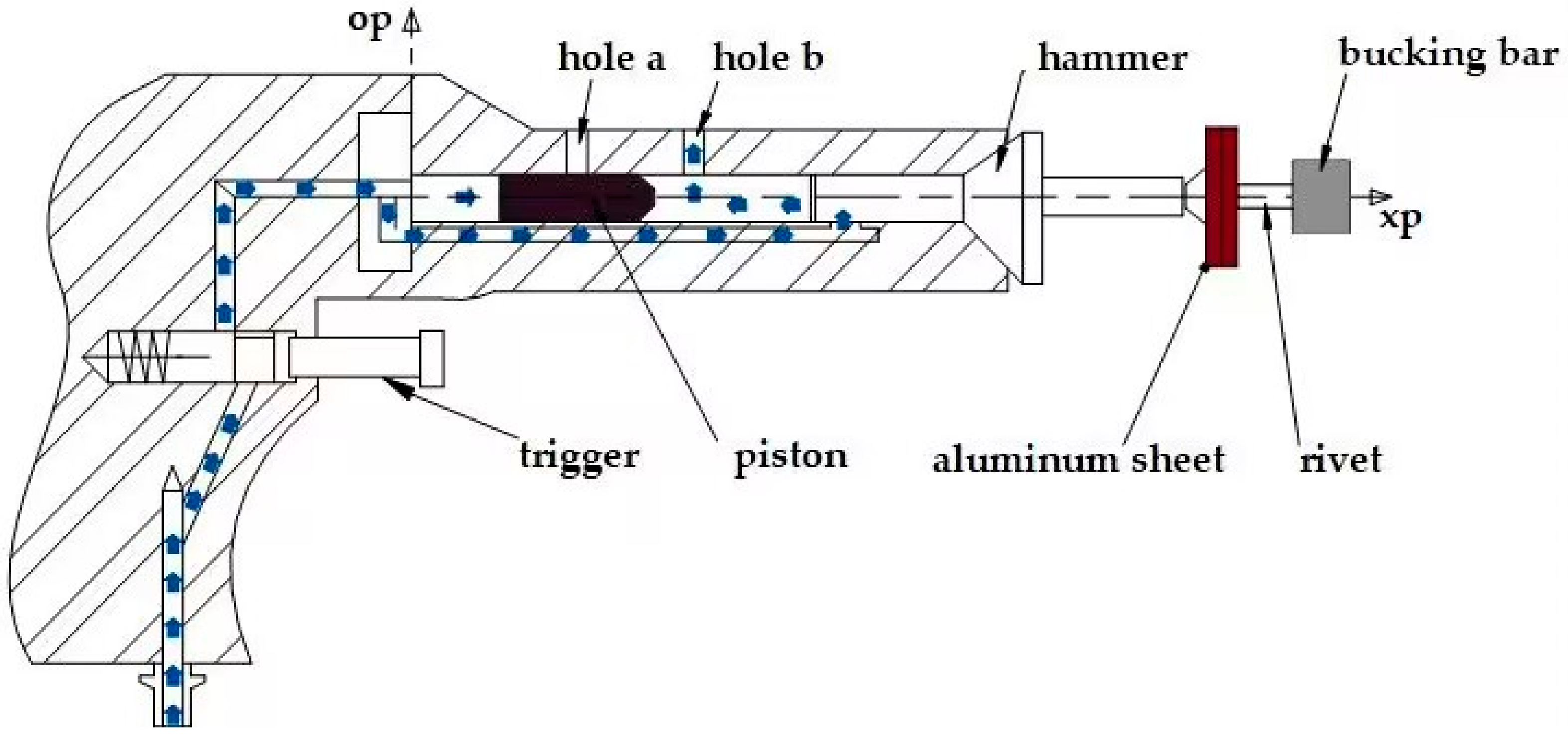
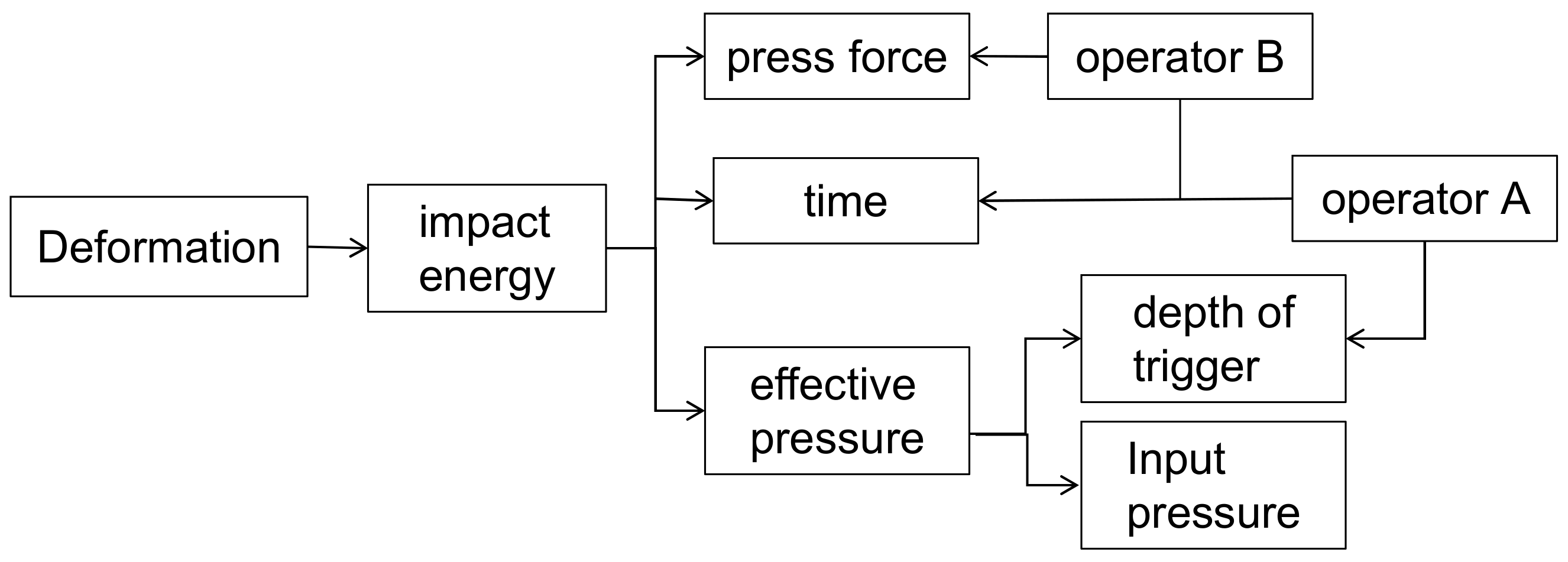
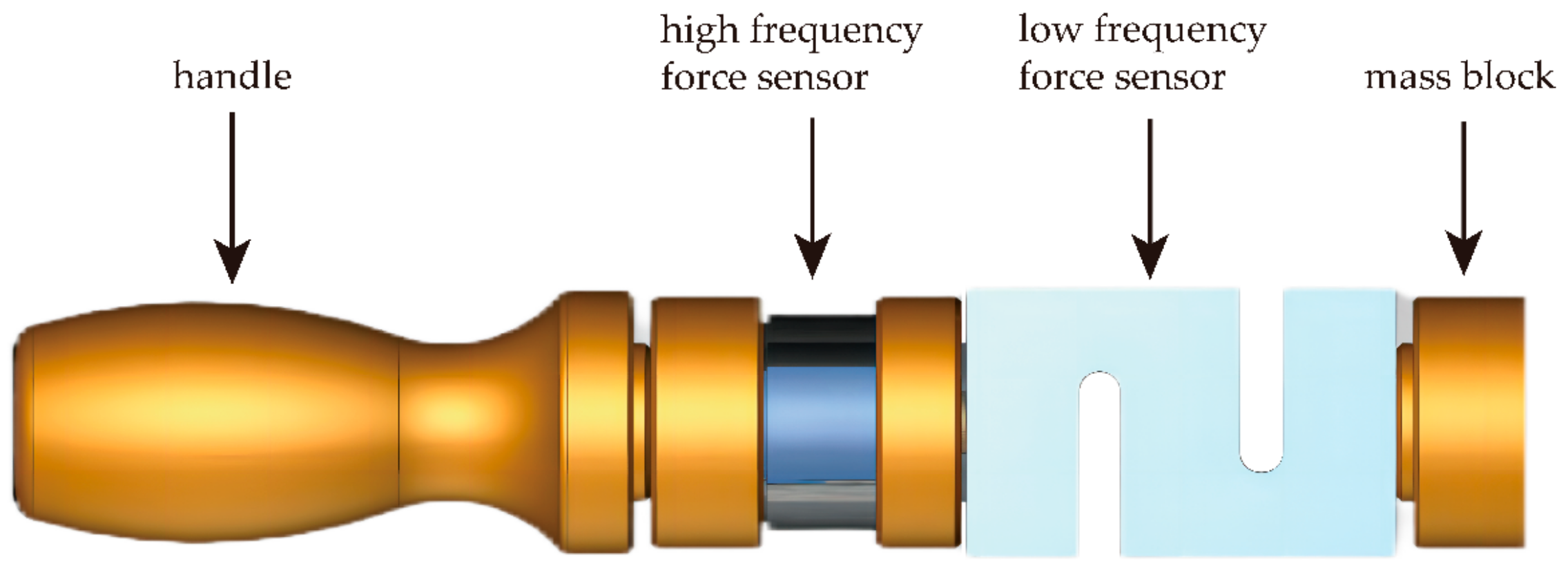
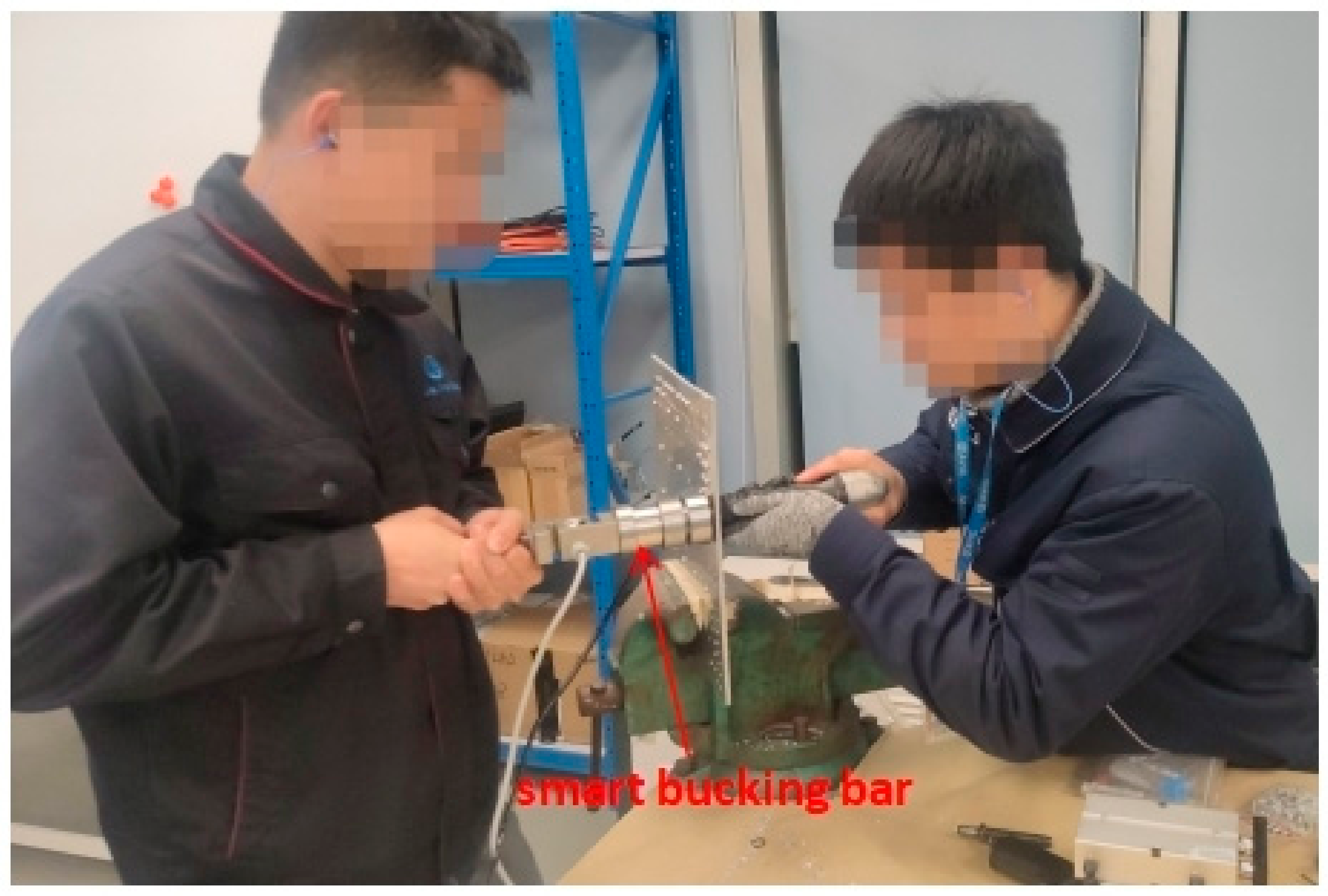


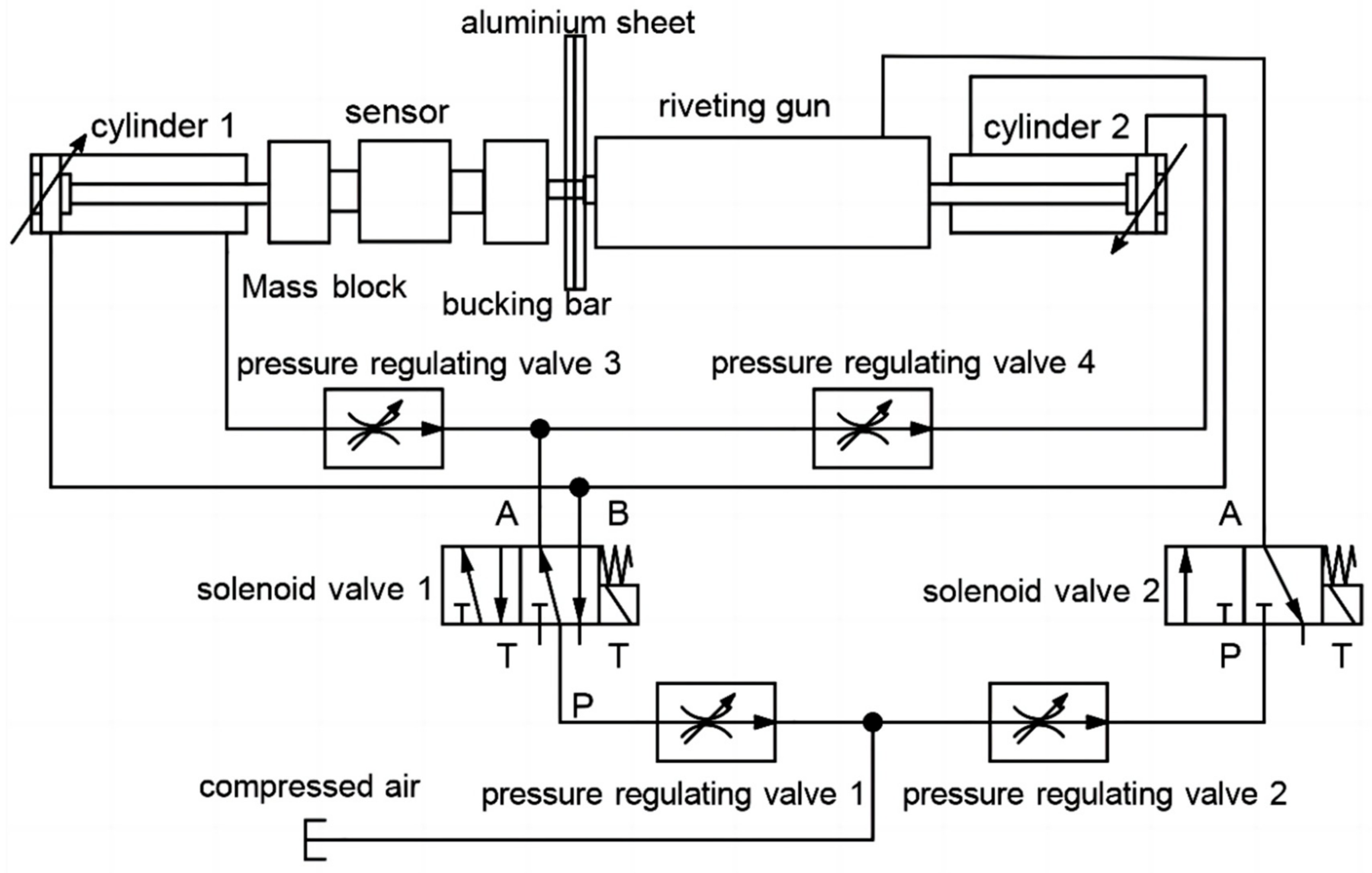
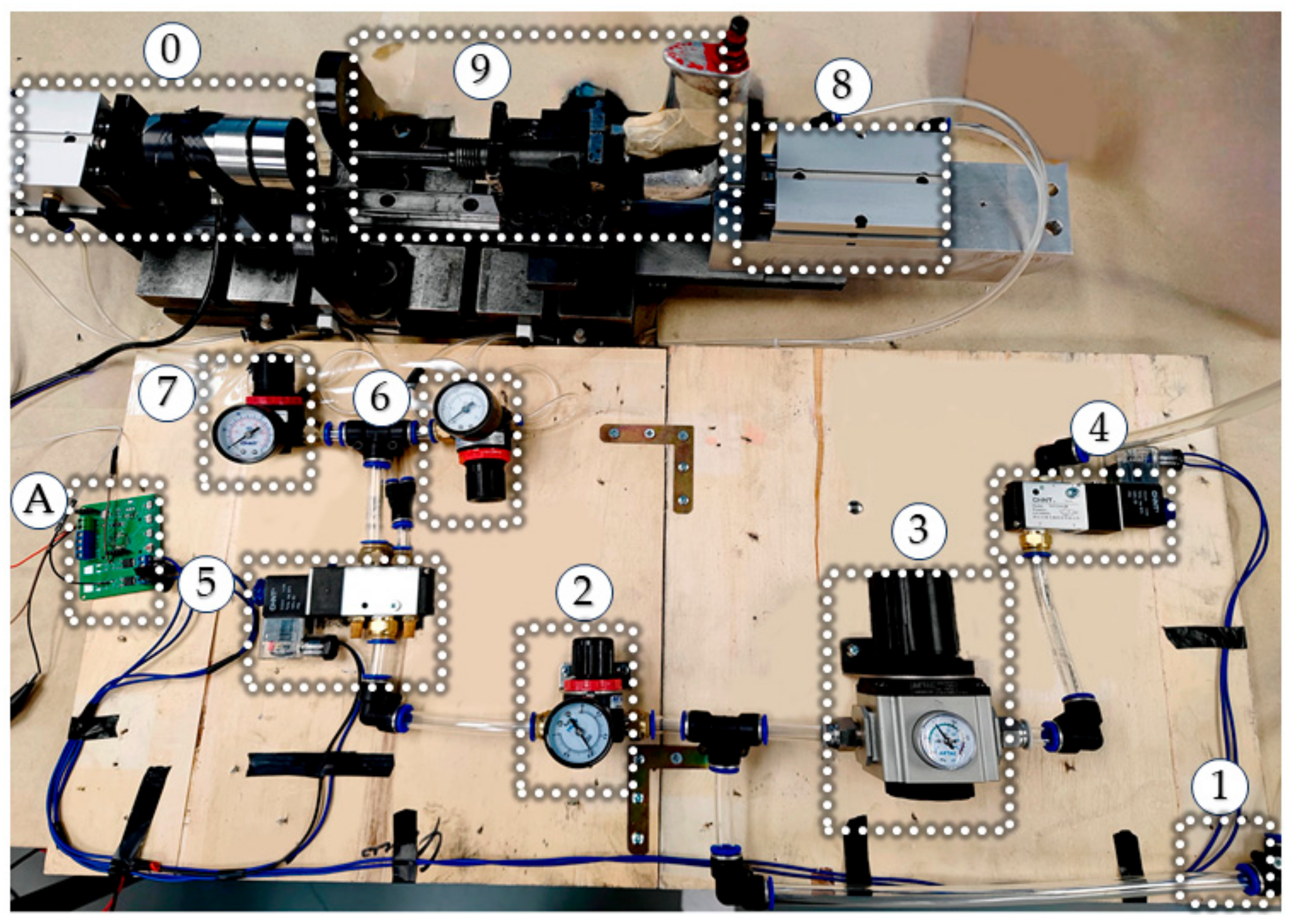
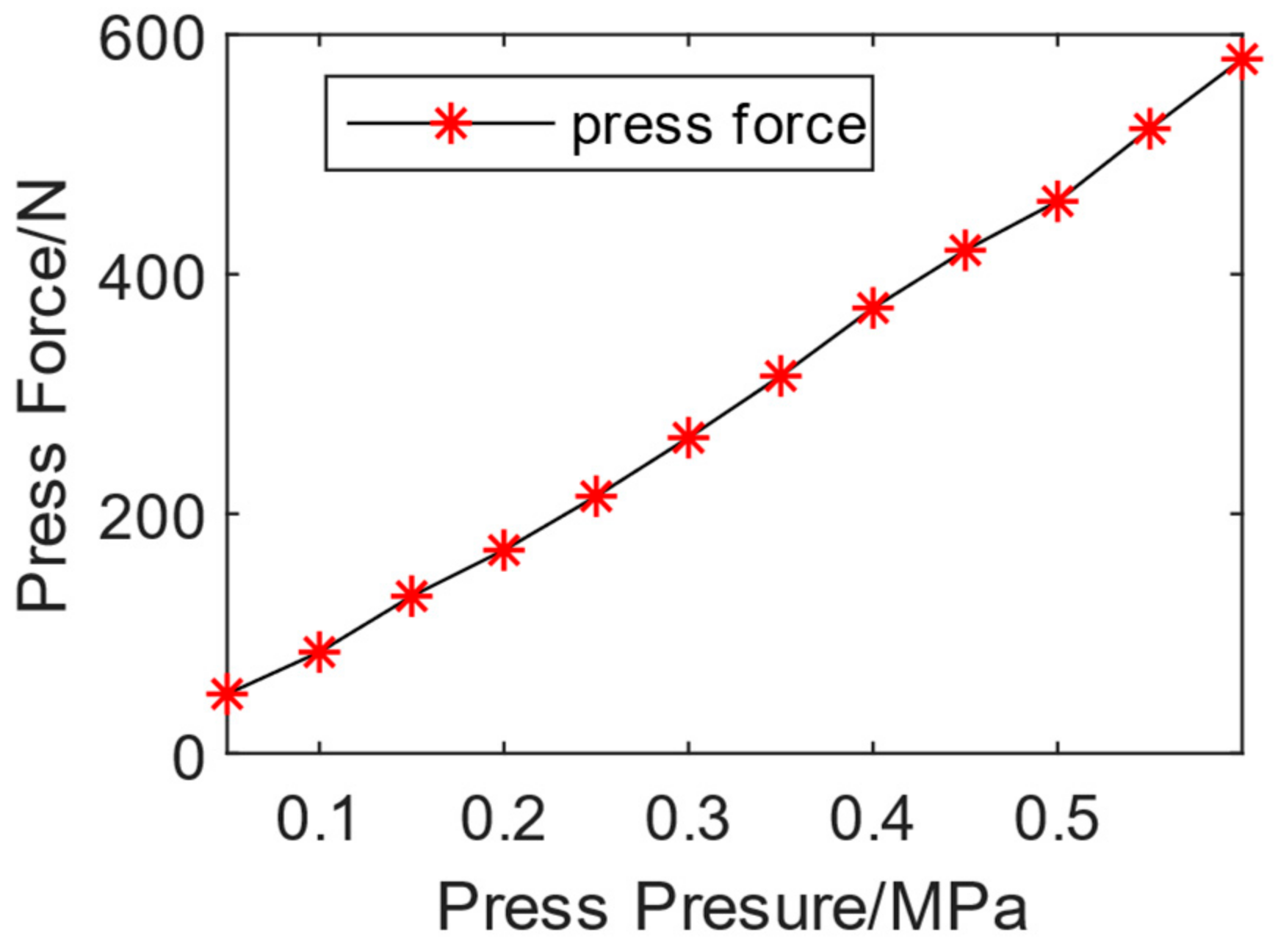
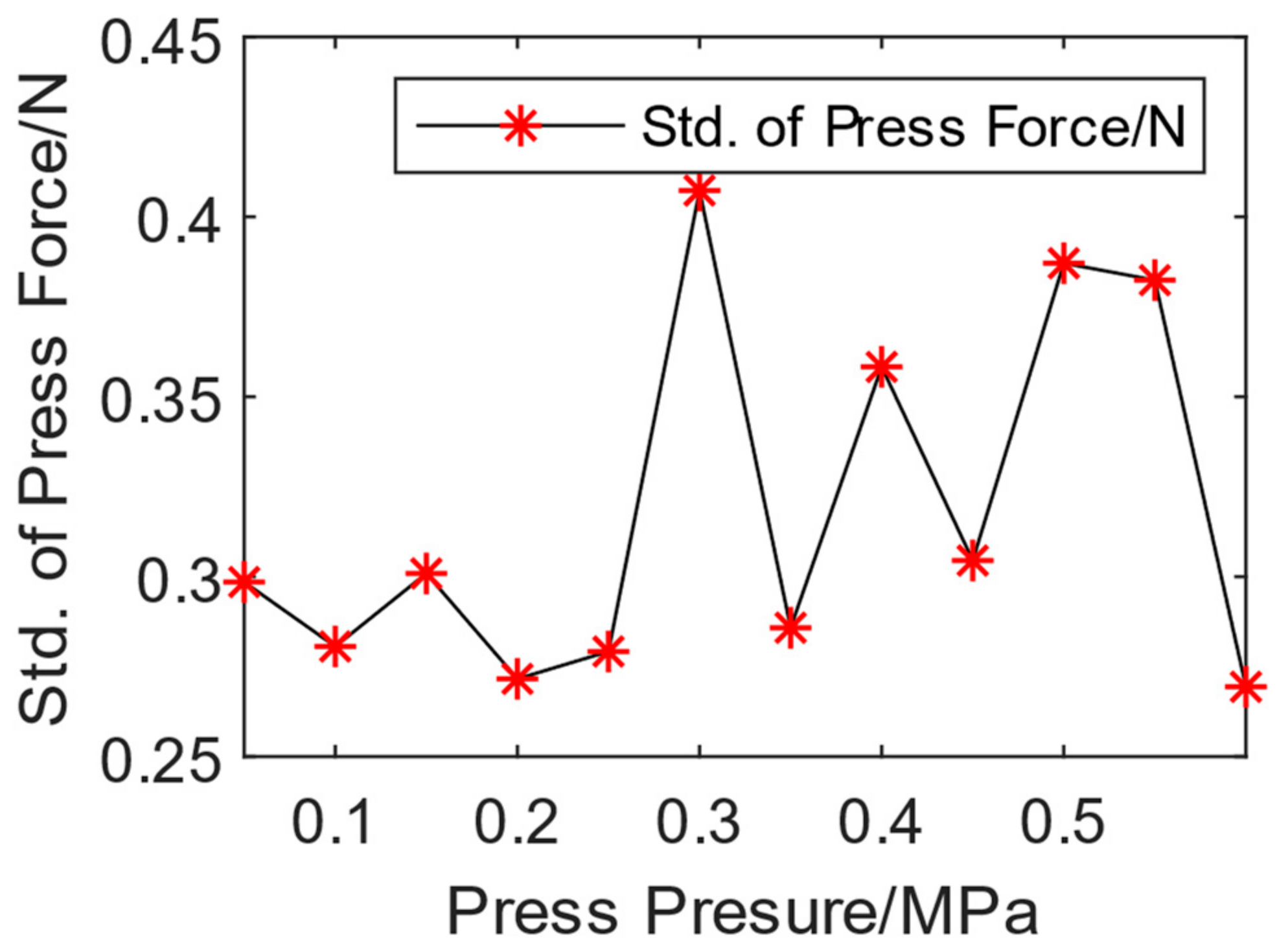
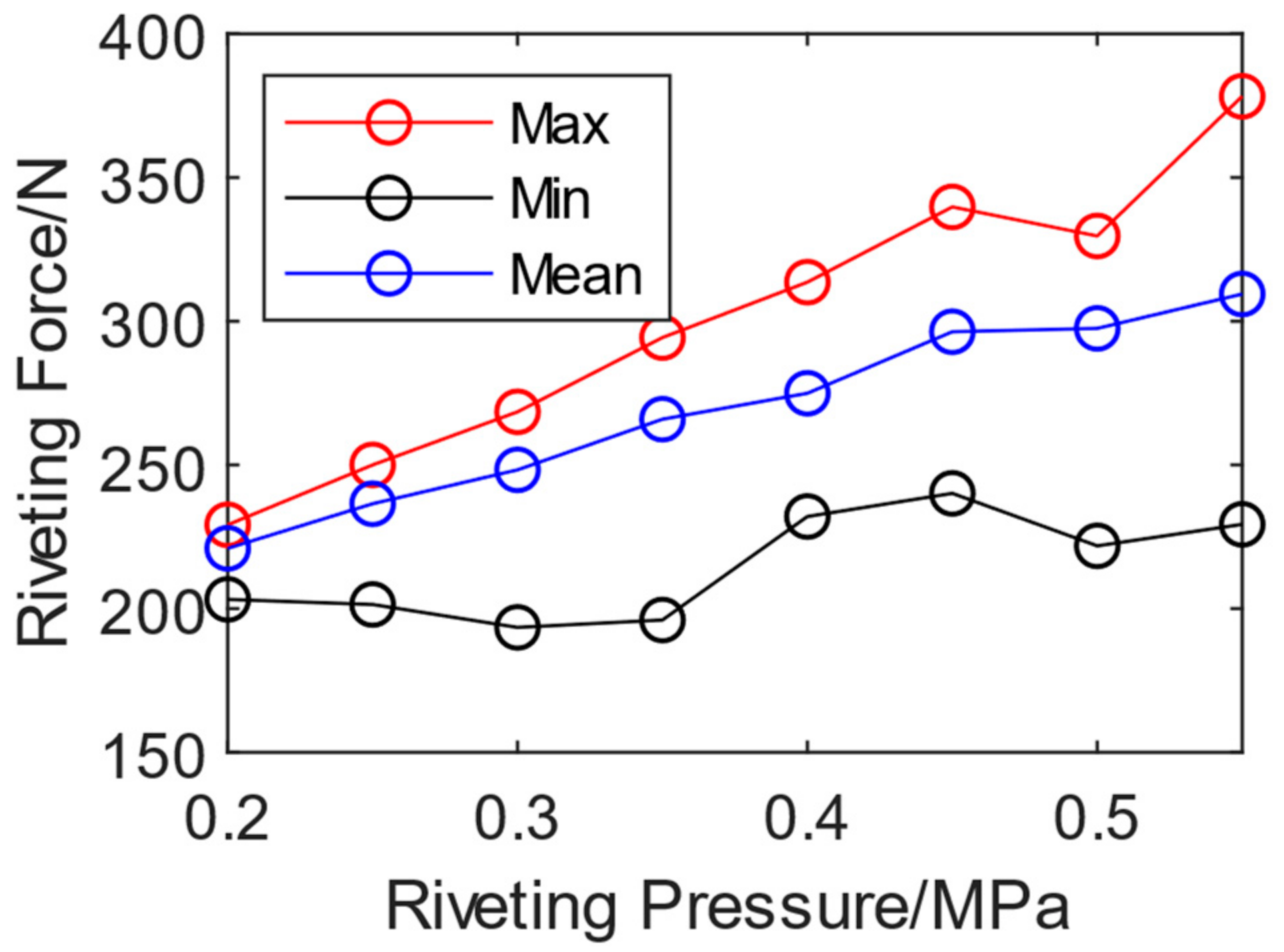
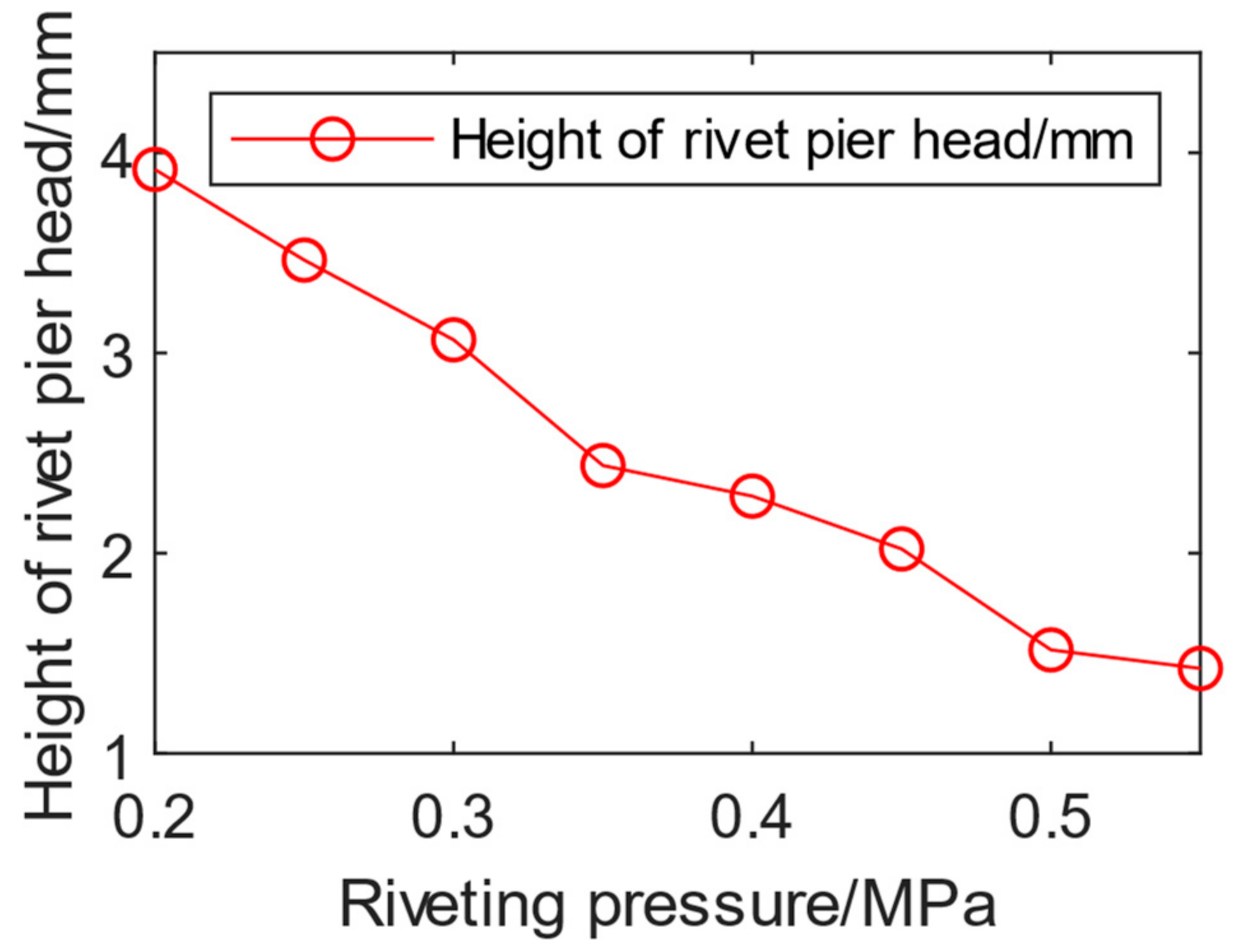

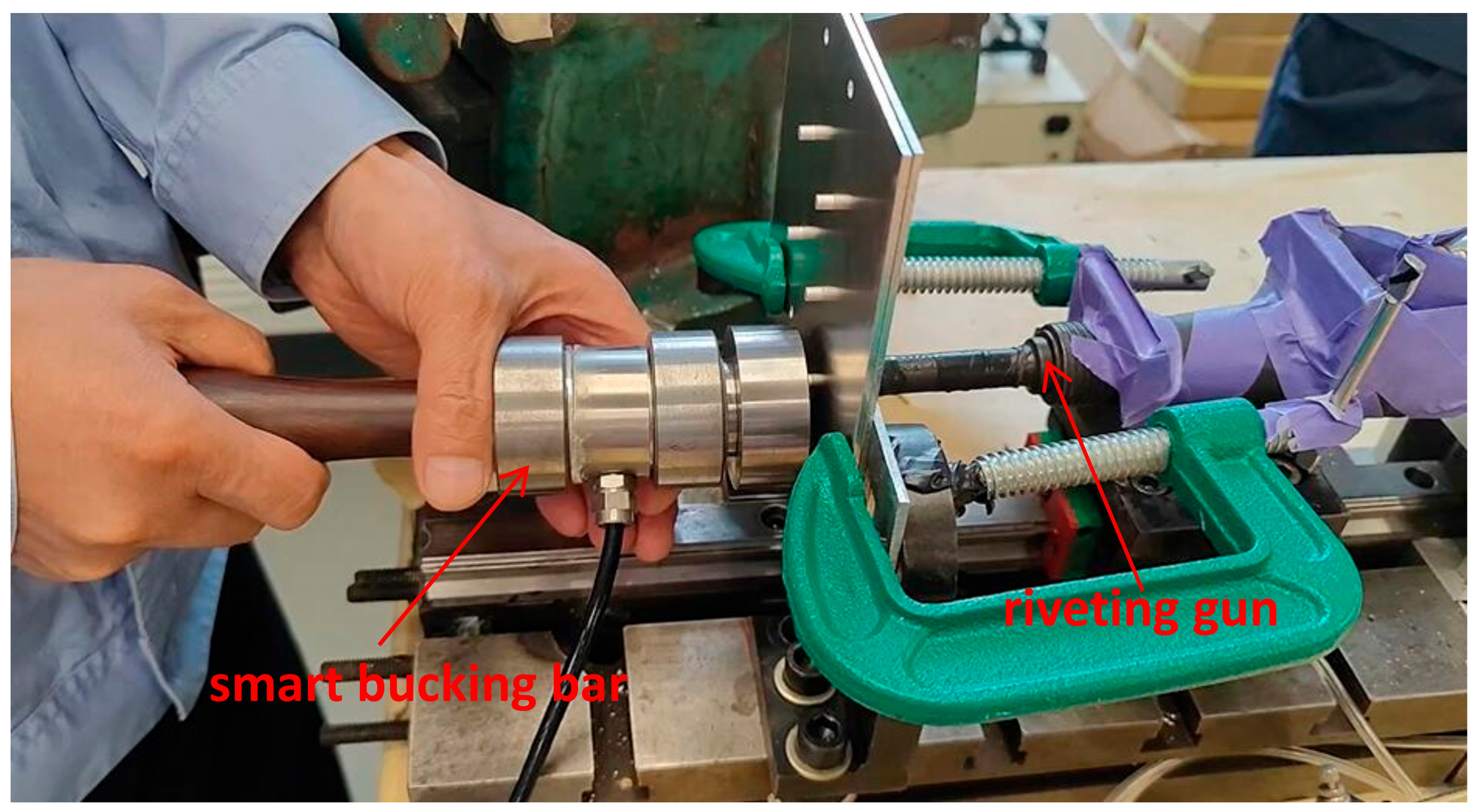
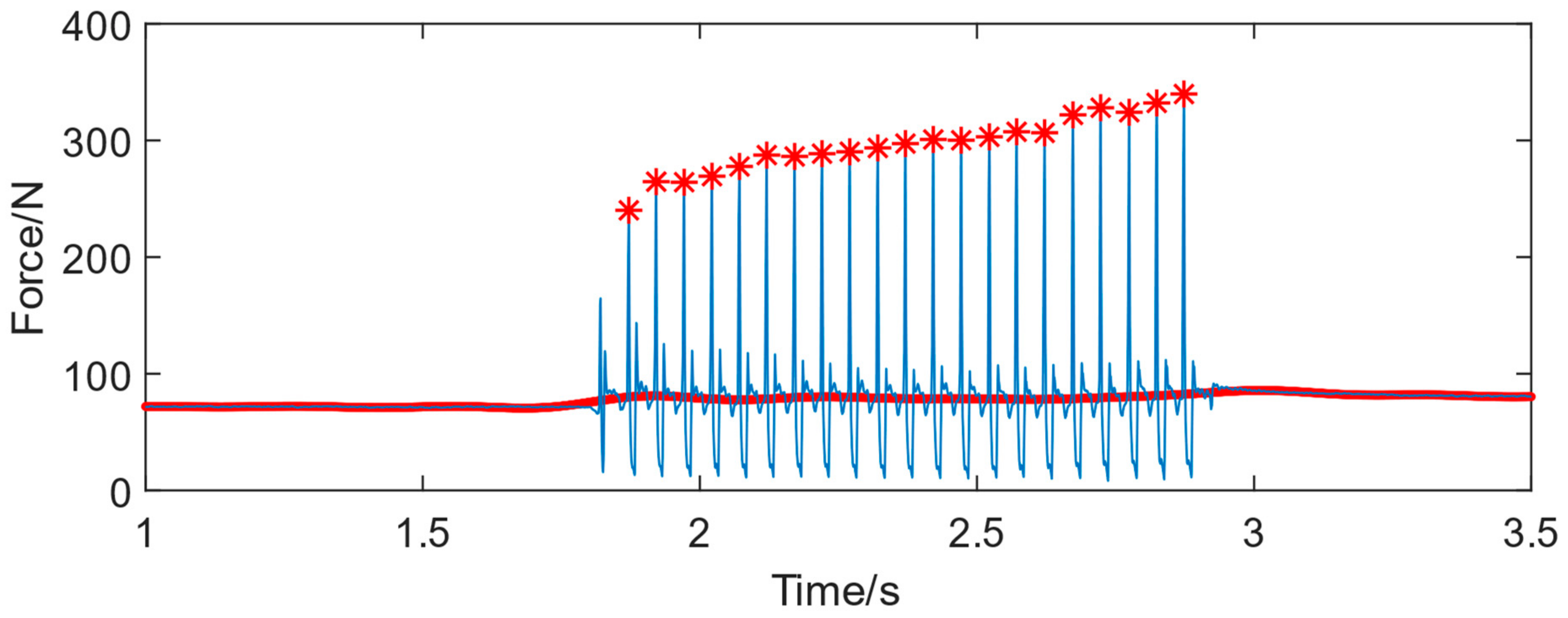
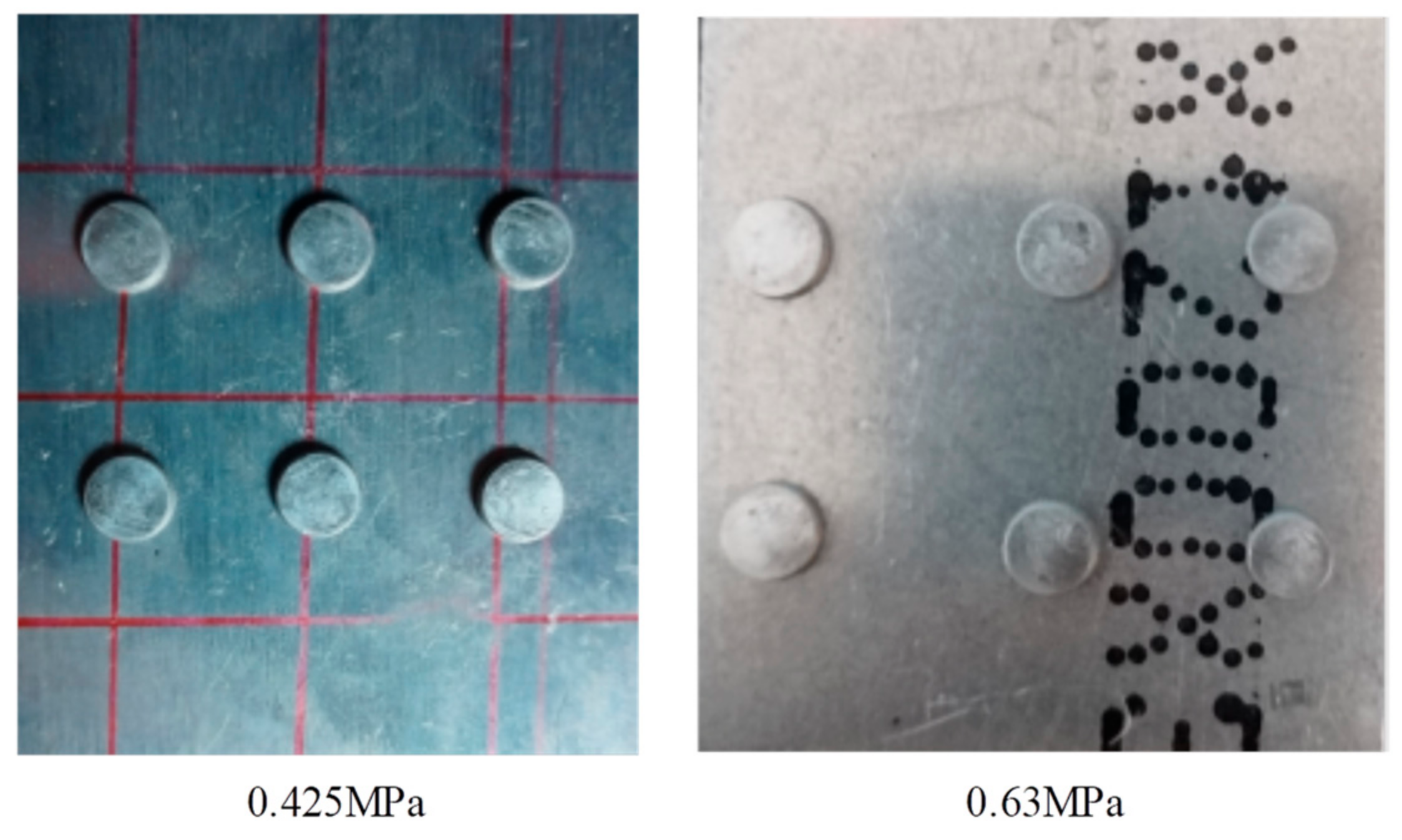
| Riveting Ability | Impact Energy | Impact Frequency | Gas Consumption | Working Pressure | Tool Weight |
|---|---|---|---|---|---|
| Al 5 mm | 3.9 J | 25 HZ | 4.16 L/s | 6.3 kg | 1.18 kg |
| No. | Time/s | The Peak of Riveting Force | Press Force/N | No. of Impacts | Head Height/mm | |||
|---|---|---|---|---|---|---|---|---|
| Max./N | Min./N | Mean./N | Std. | |||||
| 1 | 1.92 | 436.79 | 250.80 | 371.48 | 45.27 | 213.30 | 26 | 2.01 |
| 2 | 1.78 | 413.92 | 278.91 | 337.11 | 35.62 | 201.40 | 26 | 2.11 |
| 3 | 1.79 | 410.43 | 293.48 | 362.82 | 34.66 | 253.62 | 30 | 1.81 |
| 4 | 1.65 | 317.92 | 233.42 | 283.60 | 18.08 | 103.00 | 30 | 2.02 |
| 5 | 1.35 | 393.71 | 269.50 | 327.10 | 33.36 | 186.60 | 25 | 2.02 |
| 6 | 1.64 | 315.91 | 203.36 | 252.94 | 33.39 | 98.62 | 26 | 2.04 |
| 7 | 1.55 | 333.45 | 209.84 | 265.23 | 39.83 | 93.90 | 26 | 2.00 |
| 8 | 1.89 | 291.44 | 126.91 | 236.47 | 42.95 | 71.36 | 31 | 1.89 |
| 9 | 1.93 | 366.76 | 210.23 | 291.51 | 43.51 | 137.90 | 30 | 1.91 |
| Item | No. 1 | No. 2 |
|---|---|---|
| Riveting pressure | 0.425 MPa | 0.63 MPa |
| Riveting time | 1.0 s | 0.5 s |
| Rivet material | 2A10 | 2A10 |
| Rivet No. | HB6298 | HB6298 |
| Aluminum plate 1 | 2A12 | 2A12 |
| Aluminum plate 2 | 2A12 | 2A12 |
| Press Pressure | 0.1–0.3 MPa | 0.1–0.3 MPa |
| Riveting Pressure/Mpa | 1 | 2 | 3 | 4 | 5 | 6 | 7 | 8 | Std. | Range |
|---|---|---|---|---|---|---|---|---|---|---|
| 0.425 | 2.11 | 2.10 | 2.19 | 2.20 | 2.14 | 2.12 | 2.18 | 2.17 | 0.04 | 0.1 |
| 0.63 | 2.00 | 2.01 | 2.11 | 2.04 | 2.32 | 2.31 | 2.30 | 2.25 | 0.53 | 0.32 |
Disclaimer/Publisher’s Note: The statements, opinions and data contained in all publications are solely those of the individual author(s) and contributor(s) and not of MDPI and/or the editor(s). MDPI and/or the editor(s) disclaim responsibility for any injury to people or property resulting from any ideas, methods, instructions or products referred to in the content. |
© 2023 by the authors. Licensee MDPI, Basel, Switzerland. This article is an open access article distributed under the terms and conditions of the Creative Commons Attribution (CC BY) license (https://creativecommons.org/licenses/by/4.0/).
Share and Cite
Tian, Y.; Li, J.; Dan, J.; Shu, Y.; Liu, C.; Li, R.; Liu, S. Extracting Technicians’ Skills for Human–Machine Collaboration in Aircraft Assembly. Biomimetics 2023, 8, 604. https://doi.org/10.3390/biomimetics8080604
Tian Y, Li J, Dan J, Shu Y, Liu C, Li R, Liu S. Extracting Technicians’ Skills for Human–Machine Collaboration in Aircraft Assembly. Biomimetics. 2023; 8(8):604. https://doi.org/10.3390/biomimetics8080604
Chicago/Turabian StyleTian, Yaling, Ji Li, Junjie Dan, Yongsheng Shu, Chang Liu, Ruijie Li, and Shiyong Liu. 2023. "Extracting Technicians’ Skills for Human–Machine Collaboration in Aircraft Assembly" Biomimetics 8, no. 8: 604. https://doi.org/10.3390/biomimetics8080604
APA StyleTian, Y., Li, J., Dan, J., Shu, Y., Liu, C., Li, R., & Liu, S. (2023). Extracting Technicians’ Skills for Human–Machine Collaboration in Aircraft Assembly. Biomimetics, 8(8), 604. https://doi.org/10.3390/biomimetics8080604





